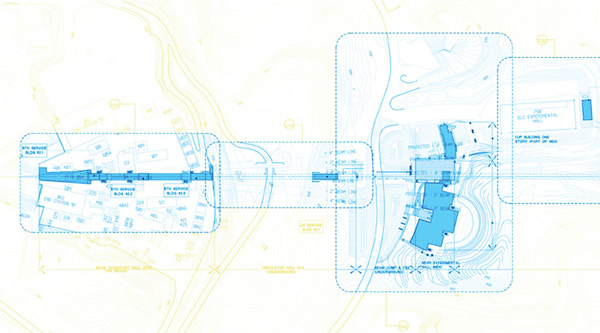New life for a linac
How the Stanford Linear Accelerator Center is transforming the worlds longest linear accelerator into a novel X-ray laser.
by Heather Rock Woods
|
|
|
The Linac Coherent Light Source, currently under construction at Stanford Linear Accelerator Center, starts with the existing linear accelerator and adds new sections to complete an X-ray laser. |
Forty-year-old scientific equipment tends to live in storage closets, recycling yards, or the occasional museum. However, the 3-kilometer-long Stanford Linear Accelerator, built in 1966, is merely reaching middle age.
Still doing what it knows best—boosting bunches of electrons to near the speed of light—the linear accelerator, or "linac" to its friends, will soon start a new stage of life. As the source of electrons for a new type of laser, it will be able to see materials, atoms, and molecules, in a completely new way, illuminating new vistas on clean energy, medicine, nanotechnology, and planetary science.
The linac already has an impressive résumé. At the top of the list, no doubt, are the three Nobel prizes it helped to win. It has contributed to a surprisingly wide range of experiments in particle physics, astrophysics, photon science, high-energy nuclear physics, and accelerator science. It also holds a number of titles, such as longest linac and first linear collider.
A cadre of engineers, construction crews, physicists, and designers is preparing the linac for its completely new job—electron production for a powerful, innovative X-ray laser, the Linac Coherent Light Source (LCLS). In seizing this exciting opportunity, the linac repositions itself as a major player in the future of light source science and the future of Stanford Linear Accelerator Center (SLAC). Tunnel digging and other major civil construction will begin in the coming fiscal year, but signs of LCLS construction are already evident at SLAC.
"SLACs got a huge advantage. Weve got the linac. Were saving hundreds of millions of dollars and we have the infrastructure and expertise of the lab itself."
Free electrons
LCLS will operate as a light source with a two-stage process. First, it will create extremely short, tightly-focused electron bunches, the kind only linear accelerators can make. Then, those bunches of electrons will be used to create X-rays of the intensity, duration, and coherence needed for experiments.
When the LCLS commences operations, it will join a new breed of light source called the free electron laser (FEL). Existing FELs operate in wavelengths from the low-energy infrared through to the higher-energy X-ray region. However, LCLS will be the first to operate at the highest-energy hard X-ray wavelengths, ideal for probing the fleeting motions of atoms and molecules. Using the linac's well-shaped bunches of electrons, "free" from being bound to atoms, LCLS will turn out pulses of light that are mere millionths of billionths of a second in duration, blindingly brilliant, and coherent like a laser, with all the light waves lining up in step.
Thanks to the linac, these amazingly useful pulses will start flashing soon, in 2009. "SLAC's got a huge advantage. We've got the linac. We're saving hundreds of millions of dollars and we have the infrastructure and expertise of the lab itself," says John Arthur, LCLS systems manager for photons. Even with those savings, the LCLS is still an enormous project, with the US Department of Energy's Office of Science contributing about $400 million.
Instead of having to build from scratch, the lab saves years of construction time as well. LCLS partners, including the Advanced Photon Source at Argonne National Laboratory, Lawrence Livermore National Laboratory, and the University of California, Los Angeles, are designing and building some of the essential parts, such as the undulator magnets and X-ray optics.
Several other FEL projects are being planned or constructed around the world. The German laboratory DESY opened a far-ultraviolet/soft X-ray FEL in 2005 and is planning a hard X-ray FEL to start operation in 2012. SPring-8 in Japan begins construction this year on an X-ray FEL to be completed in 2010 after a prototype operated successfully in July.
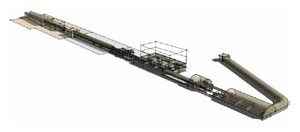 |
|
A sketch of the new underground facility that will extend the linac to create the LCLS. |
| Source: Image courtesy of the LCLS project, SLAC |
Outfitting the linac
X-rays only appear after electrons flow from an initial electron injector, through the linac, and finally into the undulator hall. Although the front and back ends will be entirely new, the linac requires surprisingly few changes.
The process starts one kilometer before the end of the existing three-kilometer linac. There, a new injector is being installed to make electrons. From the very beginning, the electron bunches are shorter and more tightly focused (called low-emittance) than those currently made by the linac's main injector.
In the new injector, a laser strikes a copper plate, called a cathode, forcing it to emit electro ns. With each pulse of the laser, the cathode lets loose about six billion electrons. Right away, the newly-freed electrons are accelerated to near the speed of light, the only way they can tolerate being closely packed. New accelerating structures boost the electrons' energy symmetrically from two sides. Like controlling a soccer ball with two feet instead of one, this dual boost keeps the electron bunches better contained and prepared for acceleration in the linac.
"You need a very high-quality electron beam. It's all designed to put electrons into a very small volume and keep them there," says Arthur; it takes a very dense clump of electrons moving in the same direction to make them act as a laser.
Crews finished construction on the building that houses the new injector in May. The drive laser arrived from France in July.
Squeezed
Following the electrons downstream, the biggest change to the linac takes place almost immediately, where bunch compressors will cram the electrons into even tighter packages.
This fall and next, during the linac's scheduled maintenance shutdowns, workers will remove 39 meters of existing accelerator structures to make room for the two bunch compressors. The first bunch compressor bends the beam through a series of magnets to squeeze each electron bunch from one-millimeter length down to 200 micrometers (one fifth of a millimeter).
Trouble starts in the second bunch compressor, where the bunch is squeezed down by a factor of ten, to 20 micrometers. Here is where the scourge of particle-physics experiments rears its ugly head.
When an electron bunch changes direction, as when it is bent by a magnet, it emits light—synchrotron radiation. If that light is emitted in step rather than randomly, it is called coherent.
"Coherent radiation is what you want in the undulator [laser cavity]. It's why we're making short pulses and low-emittance beam in the linac," says David Schultz, LCLS systems manager for electrons.
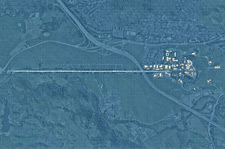 |
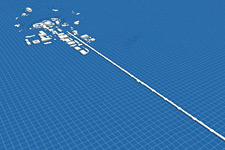 |
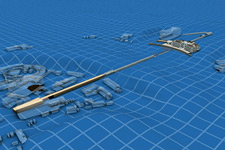 |
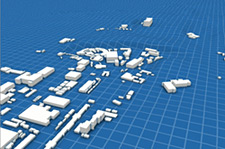 |
|
Watch the animation of the linac and LCLS. (Real Media Player required). |
|
|
Animation: Greg Stewart, SLAC |
|
While coherent light is what makes lasers so useful and powerful, it disrupts the electron bunches as they travel through the linac. To restrain in the linac the exact thing that they count on later to make the X-ray beam, physicists are making the second bunch compressor much longer than the first, which allows the electrons to take a gentler path and emit less radiation.
"Coherent synchrotron radiation is a problem all FELs face. We control it in one stage, and use it to our advantage in another stage," says Paul Emma, head of the LCLS accelerator physics group.
After the bunch compressors, the electrons will see few changes. The linac will accelerate the beam from 4.5 GeV (billions of electronvolts energy) to 14 GeV, and keep it focused with new magnets. These magnets can be turned off when the linac runs at higher energy for particle-physics experiments.
"We have to be able to switch between the old and the new ways of operating. We don't want to destroy old functionality," says Emma.
SLAC's main high-energy physics experiment, BaBar, can continue running unhindered because it uses only the first two-thirds of the linac.
Just add light
The end of the linac is not the end of the line for the electrons. The bunches, now 20 micrometers long and 50 micrometers in diameter, will coast 500 meters through new beam pipe to the undulator hall.
The electrons enter 130 meters of undulator magnets, containing 6000 north and south magnetic poles. As the poles flip signs, the electrons take a slalom course, emitting photons as they go. The emitted photons interfere with the electrons in each bunch, forcing electrons to clump together in "micro-bunches." Each micro-bunch then radiates the desired coherent X-ray light with a wavelength of 1.5 Ångstroms (0.15 billionths of a meter).
In a self-amplifying loop characteristic of a laser, the emitted X-rays stimulate the micro-bunches to release even more photons, flooding the beam pipe with a brilliant beam of coherent X-ray light.
At the end of the undulator hall, the X-ray beam heads off to the experimental hutches where it is used for experiments, while the electrons are sent to a "beam dump," a chunk of copper that soaks up the once-free electrons.
Construction zone
Much construction work will take place in the next two years before the electrons can venture beyond the linac.
David Saenz, systems manager for conventional facilities, presides over the additions: half a mile of new beam enclosures, above and below ground. A research and office building will also be erected above the near experimental hall.
Last spring, crews removed a relatively small but extremely successful research facility, the Final Focus Test Beam, to make room for the beam pipe that will carry electrons from the linac to the undulator. They are also clearing smaller buildings in the Research Yard at SLAC to make way.
In the Magnetic Measurement Facility, completed in April, physicists and technicians have begun testing and tuning the first of 33 individual undulator magnets to arrive from Argonne National Lab. The LCLS will begin operating with one linac, one undulator hall, and six experimental stations. In the future, the one-and-only linac might call upon two-thirds or even all of its length to supply up to six undulator halls, and many more experimental stations.
As major construction readies, Saenz says, "It's going to be so much fun, I just can't wait." Indeed the laboratory eagerly anticipates the next stage of life for the linac. Conversion to an X-ray lightsource makes the 40-year-old linac young again, with as much accomplishment ahead of it as has gone before.
Click here to download the pdf version of this article.



